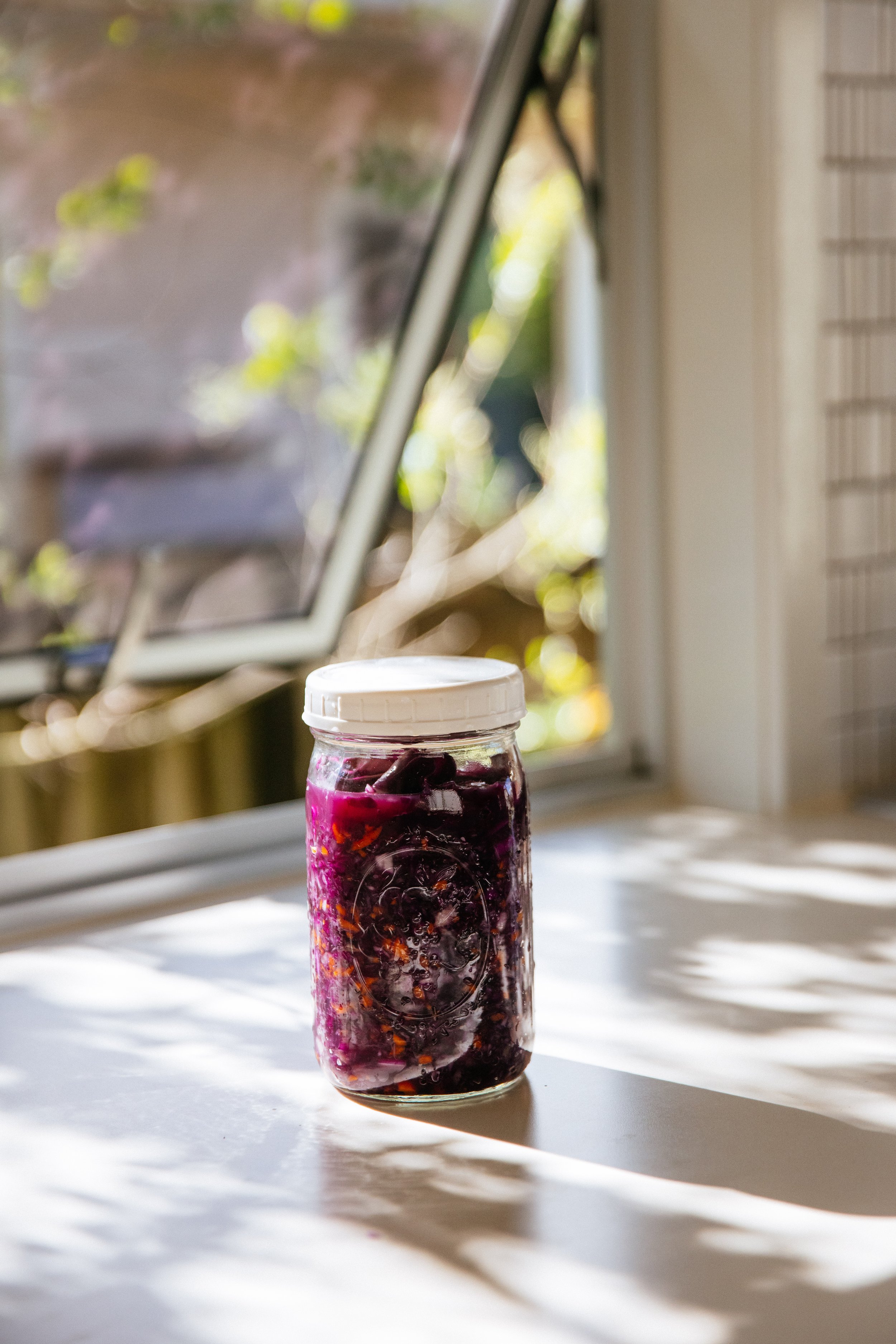Seven Steps to Successful Sauerkraut
I love sauerkraut. It's one of the simplest and safest fermented foods to make. One of the things I love most about it is that you don't need any fancy equipment to get started. All you need is a clean jar (with a wide enough mouth to get your hand in), a cabbage and some confidence to give it a go!
Below I share my seven simple steps that I've been using to make sauerkraut successfully for the last nine years. You can use these steps to make any flavour sauerkraut you like.
If you prefer to follow a recipe you will find a few of my favourites here to get you started.
Once you are confident with these recipes then you can use the seven steps below as a guide to experiment with your own flavour combinations.
Step One: Choose your cabbage
Any variety will do: green, red, wombok/Chinese cabbage or a combination of them all. For a pink kraut - use a combination of green and red cabbage. The fresher your cabbage is the better and the more juice you will be able to massage out of it.
If you want to make plain sauerkraut (i.e. cabbage and salt) skip step two and go straight on to step three.
Step Two: Add your extras (optional or leave it plain)
You can add in any combination of vegetables, herbs, spices and even fruit to add different flavours and textures to your sauerkraut or you can just keep it plain and simple. Go with flavours that work together naturally. Generally vegetables of the same family work well together.
My basic rule of thumb is to make up the bulk of my kraut with cabbage (70 to 80 per cent) then add a small amount of extra vegetables, herbs and spices for flavour.
Not all vegetables taste great fermented so I’ve created a basic list that I use regularly that are my go to add-ons:
| Vegetables/Fruit | Herbs | Spices |
|---|---|---|
| Garlic | Basil | Juniper berries |
| Ginger/turmeric | Dill | Pepper |
| Celery | Parsley | Cumin seeds |
| Cauliflower - leaves/stalk | Mint | Mustard seeds |
| Radish | Coriander | Coriander seeds |
| Peppers/capsicum | Sage | Curry leaves |
| Beetroot | Rosemary | Chili |
| Pear/apple |
Thyme | Fennel seeds |
| Carrot |
Fennel | Cloves |
| Onion/spring onion | Oregano | Caraway seeds |
Step Three: Weigh, chop, salt and rest
First weigh all your vegetables you will be using in your sauerkraut. This will tell you how much salt you will need.
My basic salt to vegetable ratio: 1kg of vegetables to 1-1.5 tablespoons of salt (sea salt or himalayan salt is best).
Save the outer leaves of your cabbage (you will use these later to weigh down your sauerkraut), then chop your vegetables and sprinkle salt on them as you go. The finer you chop your vegetables the softer your kraut will be and the easier it will be to draw out the liquid. Be careful of cutting them too fine (like in a food processor) as it can result in a soggy kraut. Resting the chopped, salted vegetables in a bowl allows time for the salt to draw the liquid out of them. The longer you leave it the more liquid will come out and the easier it will be to massage your vegetables.
Step Four: Massage
With your hands massage the vegetables squeezing out the liquid until you have a good amount pooling at the bottom of the bowl.
Step Five: Pack them in and weigh them down
Pack the vegetables tightly into your clean jar or fermentation crock. The vegetables should all be submerged under their own liquid (this creates an environment where no harmful bacteria can grow). Leave about an inch or two space at the top of your jar to allow room for the vegetables to expand then weigh them down with some cabbage leaves and a small fermentation weight, saucer or shot glass.
Step Six: Leave to ferment
Put the lid on tight and place your jar away from direct sunlight. The time it takes to ferment is dependent on a few variables: temperature, size/texture of your vegetables and taste. There are no set rules. The warmer the temperature the faster it will ferment and the longer you leave it to ferment the softer your final kraut will be and the more tangier in flavour. In summer I ferment for about 7 days and in winter about 14 days. Experiment with what works for you and don't be afraid to taste the kraut as it ferments.
Step Seven: Monitor and eat!
Keep an eye on your kraut as it ferments. The most important thing is to keep the vegetables under their liquid. In this acidic environment no harmful bacteria can survive. If any liquid spills out of your jar as it's fermenting this is totally normal just push the vegetables back down under the liquid. Once your kraut is to your liking place it in the fridge and it's ready to eat. Unopened kraut will keep for months in the fridge but once it's open it's best to use within a month.



